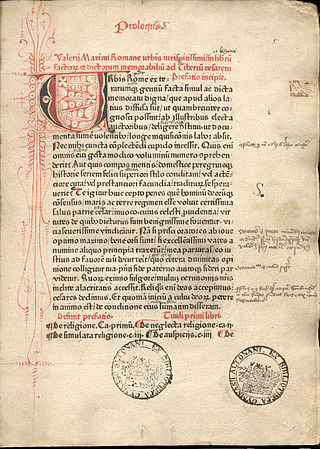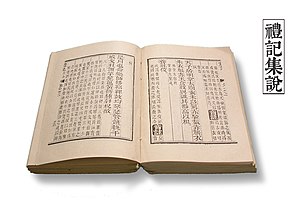
An incunable or incunabulum is a book, pamphlet, or broadside that was printed in the earliest stages of printing in Europe, up to the year 1500. Incunabula were produced before the printing press became widespread on the continent and are distinct from manuscripts, which are documents written by hand. Some authorities on the history of printing include block books from the same time period as incunabula, whereas others limit the term to works printed using movable type.

In publishing, a colophon is a brief statement containing information about the publication of a book such as an "imprint".
The Summa grammaticalis quae vocatur Catholicon, or Catholicon, is a 13th-century Latin dictionary which found wide use throughout Latin Christendom. Some of the entries contain encyclopedic information, and a Latin grammar is also included. The work was created by John Balbi, of Genoa, a Dominican, who finished it on March 7, 1286. The work served in the late Middle Ages to interpret the Bible. The Catholicon was one of the first books to be printed, using the new printing technology of Johannes Gutenberg in 1460.

The German National Library is the central archival library and national bibliographic centre for the Federal Republic of Germany. It is one of the largest libraries in the world. Its task is to collect, permanently archive, comprehensively document and record bibliographically all German and German-language publications since 1913, foreign publications about Germany, translations of German works, and the works of German-speaking emigrants published abroad between 1933 and 1945, and to make them available to the public. The DNB is also responsible for the Deutsche Nationalbibliografie and several special collections like the Deutsches Exilarchiv 1933–1945, Anne-Frank-Shoah-Bibliothek and the Deutsches Buch- und Schriftmuseum. The German National Library maintains co-operative external relations on a national and international level. For example, it is the leading partner in developing and maintaining bibliographic rules and standards in Germany and plays a significant role in the development of international library standards. The cooperation with publishers has been regulated by law since 1935 for the Deutsche Bücherei Leipzig and since 1969 for the Deutsche Bibliothek Frankfurt am Main.

The Göttingen State and University Library is the library for Göttingen University as well as for the Göttingen Academy of Sciences and is the state library for the German State of Lower Saxony. One of the largest German academic libraries, it has numerous national as well as international projects in librarianship and in the provision of research infrastructure services. In the year 2002, the SUB Göttingen won the German Library of the Year award. Its current director is Wolfram Horstmann.

Book design is the art of incorporating the content, style, format, design, and sequence of the various components and elements of a book into a coherent unit. In the words of renowned typographer Jan Tschichold (1902–1974), book design, "though largely forgotten today, [relies upon] methods and rules upon which it is impossible to improve, [and which] have been developed over centuries. To produce perfect books, these rules have to be brought back to life and applied". Richard Hendel describes book design as "an arcane subject", and refers to the need for a context to understand what that means.

Paris green is an arsenic-based organic pigment. As a green pigment it is also known as Mitis green, Schweinfurt green, Sattler green, emerald, Vienna green, Emperor green or Mountain green. It is a highly toxic emerald-green crystalline powder that has been used as a rodenticide and insecticide, and also as a pigment. It was manufactured in 1814 to be a pigment to make a vibrant green paint, and was used by many notable painters in the 19th century. The color of Paris green is said to range from a pale blue green when very finely ground, to a deeper green when coarsely ground. Due to the presence of arsenic, the pigment is extremely toxic and in paintings, the color can degrade quickly.

Neue Deutsche Biographie is a biographical reference work. It is the successor to the Allgemeine Deutsche Biographie. The 27 volumes published thus far cover more than 23,000 individuals and families who lived in the German language area (Sprachraum).

Block books or blockbooks, also called xylographica, are short books of up to 50 leaves, block printed in Europe in the second half of the 15th century as woodcuts with blocks carved to include both text (usually) and illustrations. The content of the books was nearly always religious, aimed at a popular audience, and a few titles were often reprinted in several editions using new woodcuts. Although many had believed that block books preceded Gutenberg's invention of movable type in the first part of the 1450s, it now is accepted that most of the surviving block books were printed in the 1460s or later, and that the earliest surviving examples may date to about 1451.

The Consulate of the Sea was a quasi-judicial body set up in the Crown of Aragon, later to spread throughout the Mediterranean basin, to administer maritime and commercial law. The term may also refer to a celebrated collection of maritime customs and ordinances in Catalan language, also known in English as The Customs of the Sea, compiled over the 14th and 15th centuries and published at Valencia in or before 1494.

A book cover is any protective covering used to bind together the pages of a book. Beyond the familiar distinction between hardcovers and paperbacks, there are further alternatives and additions, such as dust jackets, ring-binding, and older forms such as the nineteenth-century "paper-boards" and the traditional types of hand-binding. The term bookcover is also commonly used for a book cover image in library management software. This article is concerned with modern mechanically produced covers.

The edition notice is the page in a book containing information about the current edition, usually on the back of the title page. It often contains a copyright notice, legal notices, publication information, printing history, cataloguing information from a national library, and an ISBN that uniquely identifies the work.

The illustration of manuscript books was well established in ancient times, and the tradition of the illuminated manuscript thrived in the West until the invention of printing. Other parts of the world had comparable traditions, such as the Persian miniature. Modern book illustration comes from the 15th-century woodcut illustrations that were fairly rapidly included in early printed books, and later block books. Other techniques such as engraving, etching, lithography and various kinds of colour printing were to expand the possibilities and were exploited by such masters as Daumier, Doré or Gavarni.
Books LLC is an American publisher and a book sales club based in Memphis, Tennessee. Its primary work is collecting Wikipedia and Wikia articles and selling them as printed and downloadable books.

The following outline is provided as an overview of and topical guide to books:

The conservation and restoration of books, manuscripts, documents, and ephemera is an activity dedicated to extending the life of items of historical and personal value made primarily from paper, parchment, and leather. When applied to cultural heritage, conservation activities are generally undertaken by a conservator. The primary goal of conservation is to extend the lifespan of the object as well as maintaining its integrity by keeping all additions reversible. Conservation of books and paper involves techniques of bookbinding, restoration, paper chemistry, and other material technologies including preservation and archival techniques.
Anna Rügerin, is considered to be the first female typographer to inscribe her name in the colophon of a book, in the 15th century. In 1484, Rügerin printed two books in the in-folio format, in a press she owned in the city of Augsburg (Germany). Her work appeared less than twenty years after the arrival of the movable-type printing press in that city.
As of 2018, ten firms in Germany rank among the world's biggest publishers of books in terms of revenue: C.H. Beck, Bertelsmann, Cornelsen Verlag, Haufe-Gruppe, Holtzbrinck Publishing Group, Ernst Klett Verlag, Springer Nature, Thieme, WEKA Holding, and Westermann Druck- und Verlagsgruppe. Overall, "Germany has some 2,000 publishing houses, and more than 90,000 titles reach the public each year, a production surpassed only by the United States." Unlike many other countries, "book publishing is not centered in a single city but is concentrated fairly evenly in Berlin, Hamburg, and the regional metropolises of Cologne, Frankfurt, Stuttgart, and Munich."

The Library of Conservatism is a specialized scientific library and think tank in Berlin. Its focus is non-fiction literature by conservative, right-wing and libertarian authors from the 18th to the early 21st century. The principal foundation for the library was laid by the writer and publicist Caspar von Schrenck-Notzing who gave his extensive private collection of books. The BdK opened in 2012 in Berlin. By 2019 its catalogued stock comprised more than 30,000 items. The library is financed and supported by the Foundation for Conservative Education and Research.
Gustav Engel was a German historian.
















